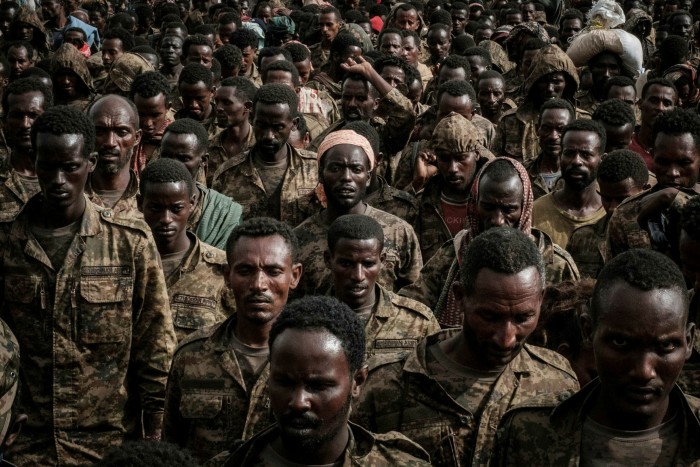[ad_1]
Soon after the Tigray People’s Liberation Front paraded Ethiopian federal prisoners of war through the streets of Mekelle this weekend, the TPLF demanded that all troops sympathetic to prime minister Abiy Ahmed withdraw from Tigray before it would agree to a ceasefire.
It was just the latest sign that the Abiy’s unilateral ceasefire, which the TPLF has called a “jokeâ€, is probably doomed, prolonging fighting that has already killed thousands and displaced 1.7m, according to the UN. It has also left over 400,000 people living in famine-like conditions and brought another 1.8m to the brink of starvation.
Ethiopia’s government had urged the rebels to join its June 28 ceasefire, which it claims would help struggling aid agencies reach hundreds of thousands of people with relief supplies. The call for a ceasefire was made as the TPLF recaptured Mekelle, the regional capital, a week ago, a triumph it called a “splendid victoryâ€.
The TPLF is now demanding that “before a ceasefire agreement is formalisedâ€, Addis Ababa must withdraw all its troops and their allies from the northern region. It has also called for an independent investigation into alleged atrocities by Ethiopian and Eritrean troops, and the reinstatement of the TPLF government in Tigray.
Abiy, who won the Nobel Peace Prize in 2018, stands accused of pursuing a conflict that has unleashed rape, massacre and alleged ethnic cleansing, and has led Washington to impose sanctions on a range of Ethiopian officials.
“We find ourselves determined and having to shed blood in order to secure our survival as people,†the TPLF said, adding that the “fascistic clique of Abiy Ahmed is, true to form, trying to hoodwink the international community into thinking that it is an agent of peaceâ€.
Addis Ababa has repeatedly declared victory in a gruesome war that Abiy once claimed would take only weeks but has instead lasted eight months and drawn in neighbouring Eritrea.
It took 10 days for the TPLF to regain control of Mekelle from Ethiopian forces, which took it last November. Fighting under the banner of its armed wing, the Tigray Defence Forces, the recapture was a blow to Addis Ababa.
Many have since questioned the ceasefire as being a ploy that would allow Abiy to regroup and rearm his forces. “This federal government ‘humanitarian’ ceasefire does not look sincere,†said William Davison, senior Ethiopia analyst at Crisis Group.
“Not only will international pressure . . . increase, given the blatant federal hampering of humanitarian operations . . . an ascendant TDF is not going to passively allow the federal government to try and constrict the region again.â€
Addis Ababa has in effect cordoned off the region. According to the UN, Tigray is now suffering a telecommunications and electricity blackout and shortages of cash and fuel that will “only exacerbate the already dire humanitarian situationâ€.
Mekelle’s recapture by the TPLF and Addis Ababa’s stance also belie what both the US state department and the EU have called the necessary conditions for an effective ceasefire.
The US has said the ceasefire “could be a positive step if it results in changes on the ground to end the conflict, stop the atrocities, and allow unhindered humanitarian assistanceâ€. The EU has similarly stressed that “to be credible, it should materialise quickly and be accompanied by additional efforts by all parties to end the conflictâ€.
But on Wednesday Ethiopia’s Lieutenant General Bacha Debele warned: “If they [the rebels] provoke us, we can go back to Mekelle today.†In one sign that fighting continues, two bridges have been blown up since the ceasefire, further hampering aid efforts. Each side has accused the other of responsibility.
The TPLF has vowed to rid Tigray of all Ethiopian federal soldiers and allied fighters from Amhara and Eritrea — and, if need be, march into Eritrea’s capital, Asmara. Before agreeing to a ceasefire, the TPLF also wants both Abiy and Eritrea’s strongman leader, Isaias Afwerki, to be held accountable for crimes allegedly committed against Tigrayans.
TPLF officials claim to have more than 9,000 Ethiopian prisoners of war and say their priority now is to push all opposing forces out of western Tigray so they can establish a supply corridor with neighbouring Sudan. They claim to have up to 30,000 troops waiting there to join the fight.
“Militarily, there is no problem in taking over western Tigray,†a TPLF official told the Financial Times. “The aim now is to try and open the corridor with Sudan.â€
Sudanese officials have said their country has no interest in getting involved in a war in Ethiopia. Nonetheless, there have been skirmishes between the Sudanese and Ethiopian forces over farmlands on the border since late last year.
Relations between Khartoum and Addis Ababa have also been strained by a giant dam that Ethiopia has built on the Nile, which Sudan fears could give Ethiopia control over the river’s vital water supplies.
Tigrayans have a long history of fighting: first in a 1940s rebellion against Emperor Haile Selassie, then in a guerrilla war against the Derg regime that led to the Tigrayans ruling Ethiopia from 1991 after they had marched on Addis Ababa.
Today, some TPLF members say the conflict, which began last November after Abiy sent troops in a response to alleged attacks on federal forces, is morphing into a fight for Tigrayan independence from Ethiopia.
“The war has not stopped,†one said. “Maybe the barrel of the gun has stopped — for now, and in some areas.â€
[ad_2]
Source link






